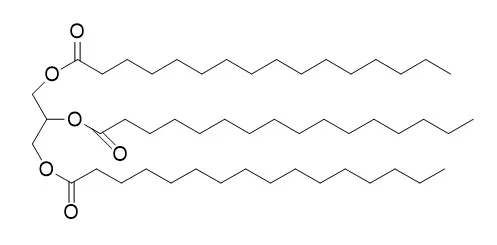| In vitro: |
| Diabetologia,2005,48:1819–1829. | | Adverse physicochemical properties of tripalmitin in beta cells lead to morphological changes and lipotoxicity in vitro.[Reference: WebLink] |
Long-term exposure of beta cells to lipids, particularly saturated fatty acids in vitro, results in cellular dysfunction and apoptosis (lipotoxicity); this could contribute to obesity-related diabetes. Our aims were to relate cell death to intracellular triglyceride concentration, composition and localisation following incubation of INS1 cells in saturated and unsaturated NEFA in high and low glucose concentrations.
METHODS AND RESULTS:
Insulin-producing INS1 cells were cultured (24 h; 3 and 20 mmol/l glucose) with palmitic, oleic or linoleic acids and the resulting intracellular lipids were analysed by gas chromatography and microscopy. Cell death was determined by quantitative microscopy and 3-(4,5-dimethylthiazol-2-yl)-2,5-diphenyltetrazolium bromide (MTT) assay, and glucose-stimulated insulin secretion by ELISA.
All NEFA (0.5 mmol/l, 0.5% albumin) inhibited glucose-stimulated (20 mmol/l) insulin secretion. Cytotoxicity was evident only with palmitic acid (p<0.05), in which case intracellular triglyceride consisted largely of Tripalmitin in angular-shaped dilated endoplasmic reticulum. Cytotoxicity and morphological disruption were reduced by addition of unsaturated NEFA. Triglyceride content (control cells; 14.5 ng/μg protein) increased up to 10-fold following incubation in NEFA (oleic acid 153.2 ng/μg protein; p<0.05) and triglyceride and phospholipid fractions were both enriched with the specific fatty acid added to the medium (p<0.05).
METHODS AND RESULTS:
In INS1 cells, palmitic acid is converted in the endoplasmic reticulum to solid Tripalmitin (melting point >65°C), which could induce endoplasmic reticulum stress proteins and signal apoptosis; lipid-induced apoptosis would therefore be a consequence of the physicochemical properties of these triglycerides. Since cellular triglycerides composed of single species of fatty acid are not likely to occur in vivo, destruction of beta cells by saturated fatty acids could be predominantly an in vitro scenario. | | Polymer Bulletin, 2013, 70(4):1383-1395. | | Additive effects of tripalmitin on morphologies and tensile properties of polybutene-1 and its composite with micro fibrous cellulose.[Reference: WebLink] | Morphologies and tensile properties of polybutene-1 (PB)/Tripalmitin (TP) blend and PB/micro fibrous cellulose (MFC)/TP composite were studied.
METHODS AND RESULTS:
The scanning electron microscope observation showed that the PB(70 %)/TP(30 %) had a microphase-separated structure. The DSC measurement showed that the crystallization of the PB part was affected by the TP existence. A new crystal structure was observed in the X-ray diffraction pattern of the PB(70 %)/TP(30 %). Quicker saturation of the PB crystal phase transformation from the metastable tetragonal (II) to the stable hexagonal (I) phase was observed in the PB(70 %)/TP(30 %) under the aging at r.t. The saturation controlled the Young’s modulus increment of the PB(70 %)/TP(30 %) in the aging process. The elongation at break value of the PB/TP increased by the loading of the TP, suggesting that the TP worked as the plasticizer.
CONCLUSIONS:
The thermogravimetry measurement of the PB(70 %)/TP(30 %) suggested that there existed an interaction between them. The TP addition provided a good dispersibility and ductility enhancement for PB/MFC composite. It was found that the TP worked as a good compatibilizer for the composite.
|
|






 Cell. 2018 Jan 11;172(1-2):249-261.e12. doi: 10.1016/j.cell.2017.12.019.IF=36.216(2019)
Cell. 2018 Jan 11;172(1-2):249-261.e12. doi: 10.1016/j.cell.2017.12.019.IF=36.216(2019) Cell Metab. 2020 Mar 3;31(3):534-548.e5. doi: 10.1016/j.cmet.2020.01.002.IF=22.415(2019)
Cell Metab. 2020 Mar 3;31(3):534-548.e5. doi: 10.1016/j.cmet.2020.01.002.IF=22.415(2019) Mol Cell. 2017 Nov 16;68(4):673-685.e6. doi: 10.1016/j.molcel.2017.10.022.IF=14.548(2019)
Mol Cell. 2017 Nov 16;68(4):673-685.e6. doi: 10.1016/j.molcel.2017.10.022.IF=14.548(2019)